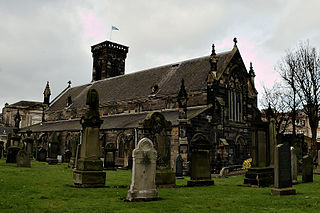
The Dean Cemetery is a historically important Victorian cemetery north of the Dean Village, west of Edinburgh city centre, in Scotland. It lies between Queensferry Road and the Water of Leith, bounded on its east side by Dean Path and on its west by the Dean Gallery. A 20th-century extension lies detached from the main cemetery to the north of Ravelston Terrace. The main cemetery is accessible through the main gate on its east side, through a "grace and favour" access door from the grounds of Dean Gallery and from Ravelston Terrace. The modern extension is only accessible at the junction of Dean Path and Queensferry Road.

David Alan Stevenson was a lighthouse engineer who built 26 lighthouses in and around Scotland.

Sir James Balfour Paul was the Lord Lyon King of Arms, the officer responsible for heraldry in Scotland, from 1890 until the end of 1926.

Edward Theodore Salvesen, Lord Salvesen, was a British lawyer, politician and judge who rose to be a Senator of the College of Justice.

Charles John Guthrie, Lord Guthrie FRSE FRSGS LLD was a Scottish judge and lawyer.

Arthur George Sydney Mitchell was a Scottish architect. He designed a large number of bank branches, country houses, churches, and church halls. His most significant commissions include the housing developments at Well Court and Ramsay Garden, both in Edinburgh.
George James Lidstone FIA FSA FRSE (1870–1952) was a British actuary who made several contributions to the field of statistics. He is known for Lidstone smoothing and Lidstone series. He served as President of the Faculty of Actuaries from 1924 to 1926.

Sir George Washington Browne was a Scottish architect. He was born in Glasgow, and trained there and in London. He spent most of his career in Edinburgh, although his work can be found throughout Scotland and beyond. He was involved in nearly 300 projects, including many public and commercial buildings. One of his most notable buildings is Edinburgh's Central Library, and he became recognised as an authority on library planning and design. He came to national attention after winning a competition to design a bridge over the River Thames in London, although this was never realised. He was the first architect to be elected as President of the Royal Scottish Academy. He also served as President of the Edinburgh Architectural Association, and was instrumental in setting up the Royal Fine Art Commission for Scotland.

Warriston Cemetery is a cemetery in Edinburgh. It lies in Warriston, one of the northern suburbs of Edinburgh, Scotland. It was built by the then newly-formed Edinburgh Cemetery Company, and occupies around 14 acres (5.7 ha) of land on a slightly sloping site. It contains many tens of thousands of graves, including notable Victorian and Edwardian figures, the most eminent being the physician Sir James Young Simpson.

Thomas Bond Sprague FRSE FFA FIA LLD was a British actuary, barrister and amateur mathematician who was the only person to have been President of both the Institute of Actuaries (1882–1886) in London and the Faculty of Actuaries (1894–1896) in Edinburgh, prior to their merger in 2010.
Sir Thomas Clark FRSE DL (1823–1900) was a Scottish publisher and politician who served as Lord Provost of Edinburgh from 1885 to 1888.
William Evans FRSE FFA FSA MBOU (1851–1922) was a Scottish naturalist, ornithologist and actuary. He was described as one of the most competent field naturalists of his day. He served as President of the Royal Physical Society of Edinburgh.
Sir David Paulin FFA FRSE (1847–1930) was a Scottish banker and actuary and the first person within the insurance industry to be knighted. Together with James Sorley he founded the Scottish Life Assurance Company in 1881. He managed the company from 1881 to 1918 under the chairmanship of Sir Arthur Mitchell.

James Grant FRSE DD DCL was a Scottish minister. Combining his religious skills with business skills he was also Director of Scottish Widows for 50 years and Moderator of the General Assembly of the Church of Scotland in 1854. During his period as Moderator he was styled as Right Rev James Grant and thereafter as Very Rev James Grant.
James Gray Kyd CBE FFA FRSE was a Scottish actuary who was Registrar General for Scotland from 1937 to 1949 and president of the Faculty of Actuaries from 1944 to 1946.

John MacGregor McCandlish WS FRSE (1821–1901) was a Scottish lawyer and actuary. He was the first president of the Faculty of Actuaries.
George Smith CIE FRGS LLD was a 19th-century Scottish historian and geographer who spent his working life in India. He was father to a family of eminent figures.
James Sorley FFA FRSE (1853–1924) was a 19th/20th century Scottish actuary. In 2001 the company was absorbed into the Royal London Group.
George Ann Panton FRSE (1842–1903) was a 19th-century Scottish merchant and noted amateur botanist and geologist. In later life he was an actuary by trade with links to Birmingham.

William Thomas Thomson FRSE FFA (1813–1883) was a 19th-century Scottish actuary who was manager of the Standard Life Assurance Company 1834 to 1878 and changed the face of insurance through use of mortality rates. His use of actuarial tables became common practice across the globe in the field of life insurance.












